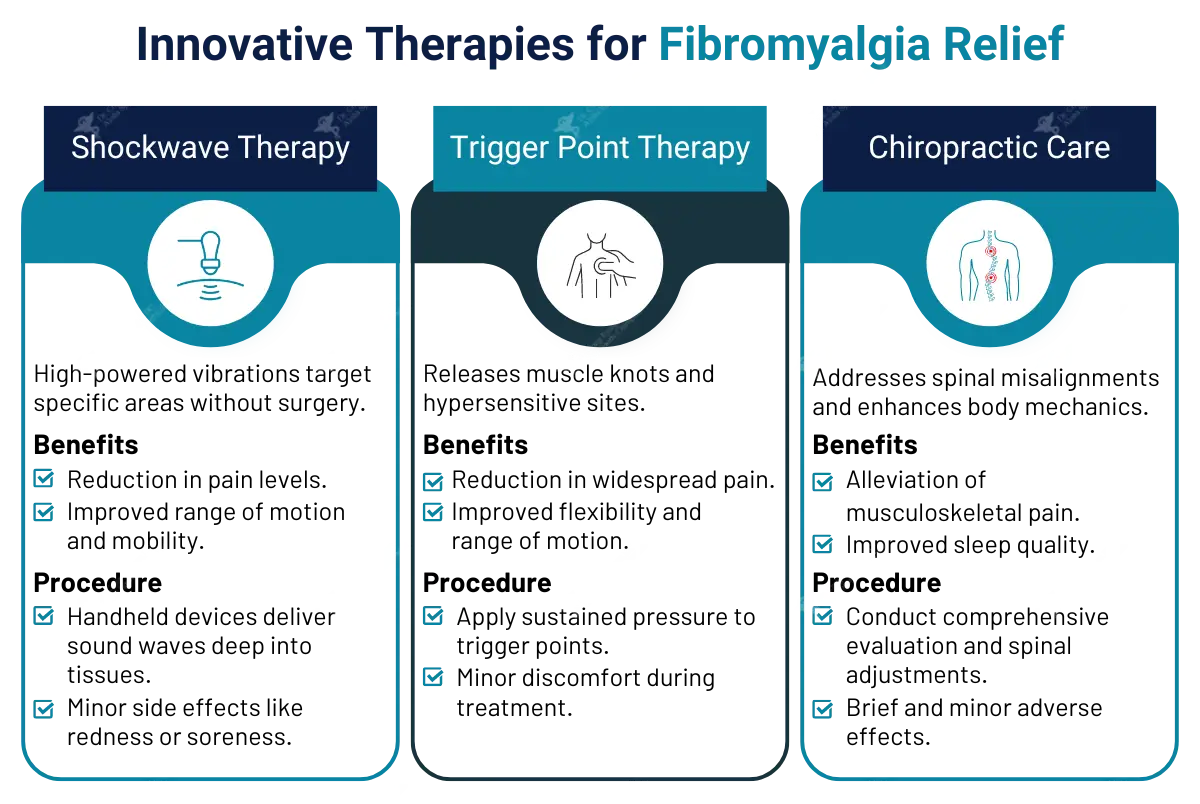
Fibromyalgia is a chronic disorder that causes extensive pain in the muscles. As a chiropractor with 25 years of expertise, I’ve seen how fibromyalgia may affect a person’s life.
Fibromyalgia symptoms include extensive physical pain, exhaustion, sleep disruptions, and cognitive issues, making it difficult to complete daily chores. Over the years, I’ve had countless patients come to me, desperate for relief from their debilitating fibromyalgia symptoms.
Even though there is no one-size-fits-all cure, I’ve found that specific therapies help relieve this condition’s severe symptoms.
In this blog post, I will discuss shockwave therapy, trigger point therapy, and chiropractic care, three popular fibromyalgia treatments.
1. Shockwave Therapy
As an expert, I am always searching for innovative therapies to help my patients suffering from fibromyalgia. ESWT uses high-powered vibrations to target particular areas without requiring surgery. A handheld gadget delivers sound waves deep into tissues, encouraging the body’s natural healing processes.
Benefits for Fibromyalgia Patients
In my experience, shockwave therapy has been incredibly beneficial for fibromyalgia patients. It works by disrupting pain receptors and releasing painkillers. Many of my patients have reported significant reductions in their overall pain levels after undergoing this therapy (1).
Secondly, shockwave therapy can improve range of motion and overall mobility by reducing muscle tension and stiffness. This makes it easier for people with fibromyalgia to participate in regular activities, thereby improving their standard of life.
Procedures and Side Effects
The procedure itself is straightforward. After recognizing the problem regions, the handheld device sends high-energy sound waves to the skin. Minor side effects, including transient redness or slight soreness at the treatment site, are tolerable.
2. Trigger Point Therapy
Another effective fibromyalgia treatment is trigger point therapy, often known as myofascial release or trigger point massage. Massage therapy for fibromyalgia
releases muscle knots, trigger points, and hypersensitive sites that can cause transferred pain and muscle dysfunction.
Benefits for Fibromyalgia Patients
Trigger point therapy focuses on the underlying muscle tension and trigger points. It can effectively reduce the widespread pain associated with fibromyalgia (2). After implementing this therapy, I’ve noticed remarkable improvements in my patients’ pain levels.
Additionally, when I trigger points, the muscles can relax and lengthen, improving flexibility and range of motion. It has been a game-changer for many of my fibromyalgia patients, who previously struggled with limited mobility.
Related, Diagnosis Challenges, Potential Causes and Multifaceted Management of Fibromyalgia
Procedure and Side Effects
During a trigger point therapy session, I use my fingers, elbows, or specialized tools to apply sustained pressure to the identified trigger points. This pressure helps release muscle tension and restore proper muscle function. Trigger-point therapy is typically considered secure and easily tolerated by my patients. However, some people may experience some temporary discomfort during the treatment.
3. Chiropractic Care
What kind of doctor treats fibromyalgia? As a chiropractor, I firmly believe in the effectiveness of an integrated strategy for fibromyalgia. It examines the connection between the body’s structure, especially the spine, and its operation. My goal is to restore normal alignment and enhance general body mechanics using a variety of approaches, including adjustments to the spine.
Benefits for Fibromyalgia Patients
Chiropractic therapy can make a significant difference for people with fibromyalgia. By addressing spinal misalignments and improving overall body mechanics, I’ve been able to alleviate the musculoskeletal pain associated with fibromyalgia in many of my patients.
Furthermore, many individuals with fibromyalgia suffer from sleep difficulties, which can worsen the signs. Chiropractic therapy also improves sleep quality by relieving pain and enhancing the body’s general functioning (3). I’ve witnessed firsthand how improved sleep can profoundly impact a fibromyalgia patient’s quality of life.
Chiropractic care addresses structural imbalances, improves spinal alignment, and enhances physical function. It enables my fibromyalgia patients to complete daily tasks with greater comfort and trust.
Procedures and Side Effects
Following a chiropractic session, I conduct a comprehensive evaluation to determine any areas of issue. I then do spinal adjustments with calm, precise motions to regain normal alignment. The adverse effects are usually brief and minor. Some individuals may suffer slight pain or soreness right after an adjustment.

A Comparison of the Three Protocols
While shockwave therapy, trigger point therapy, and chiropractic care share common goals—reducing pain and improving overall function—they also differ in their specific mechanisms and approaches.
Shockwave therapy uses powerful vibrations to stimulate the body’s natural healing methods. While trigger point therapy focuses on releasing tight knots or trigger points in the muscles, Chiropractic care, on the other hand, addresses structural imbalances and spinal misalignments to improve overall body mechanics.
The most efficient treatments frequently incorporate a combination of these modalities. The best results are accomplished when they are adapted to each patient’s specific demands and preferences. Through careful evaluation and open communication with my patients, I determine the optimal approach that provides lasting relief and improves overall well-being.
Chiropractic care has rejuvenated many patients, while massage and trigger point therapy provide essential muscular relief. However, shockwave therapy is a true game changer that sets my practice apart, as I’m the only one in the area offering this powerful trifecta of treatment modalities.
The Final Words
In summary, shockwave therapy, trigger point therapy, and chiropractic care offer promising treatment options for individuals who have fibromyalgia. Each approach has unique advantages and ways of action. However, they all aim to reduce discomfort, enhance mobility, and improve the general standard of life.
Combining these methods may improve their efficacy, but consult a qualified chiropractor to create a customized treatment plan.
If you have fibromyalgia, I advise you to look into these possibilities and seek help at my clinic. Together, we can find a path toward lasting relief and improved well-being. Contact my office today to discuss the best way forward for your fibromyalgia management.
REFERENCES:
- Shockwave Canada. (2024, April 24). Looking for Natural Ways to Help Fibromyalgia? Read This. Retrieved from https://shockwavecanada.com/looking-for-natural-ways-to-help-fibromyalgia-read-this/
- “What Are Trigger Points (And What Can You Do About Them).” (2024, April 24). Verywell Health. https://www.verywellhealth.com/trigger-point-2696165
- Cuyahoga Falls Chiropractic Clinic. (2024, April 06). Sleeping Better Thanks to Chiropractic Care. Retrieved from https://www.cuyahogafallschiropractic.com/chiropractic-care-improves-sleep-quality/

Meet Dr. Craig Eymann, a dedicated chiropractor and yoga enthusiast with over two decades of expertise in spinal health, sports chiropractic, and personalized care, prioritizing misalignment correction for swift injury resolution.





Leave A Comment